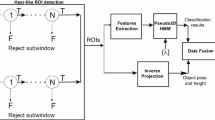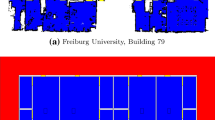Abstract
In order to solve the problem of indoor place recognition for indoor service robot, a novel algorithm, clustering of features and images (CFI), is proposed in this work. Different from traditional indoor place recognition methods which are based on kernels or bag of features, with large margin classifier, CFI proposed in this work is based on feature matching, image similarity and clustering of features and images. It establishes independent local feature clusters by feature cloud registration to represent each room, and defines image distance to describe the similarity between images or feature clusters, which determines the label of query images. Besides, it improves recognition speed by image scaling, with state inertia and hidden Markov model constraining the transition of the state to kill unreasonable wrong recognitions and achieves remarkable precision and speed. A series of experiments are conducted to test the algorithm based on standard databases, and it achieves recognition rate up to 97% and speed is over 30 fps, which is much superior to traditional methods. Its impressive precision and speed demonstrate the great discriminative power in the face of complicated environment.
Similar content being viewed by others
Explore related subjects
Discover the latest articles, news and stories from top researchers in related subjects.References
X. Gao, T. Zhang. Unsupervised learning to detect loops using deep neural networks for visual SLAM system. Autonomous Robots, vol. 41, no. 1, pp. 1–18, 2017.
Z. W. Liang, X. Gao, Y. Y. Chen, S. H. Zhu. A novel loop closure detection method in monocular SLAM. Intelligent Service Robotics, vol. 6, no. 2, pp. 79–87, 2013.
A. Pronobis, L. Jie, B. Caputo. The more you learn, the less you store: Memory-controlled incremental SVM for visual place recognition. Image and Vision Computing, vol. 28, no. 7, pp. 1080–1097, 2010.
M. Nowicki, J. Wietrzykowski, P. Skrzypczyński. Experimental evaluation of visual place recognition algorithms for personal indoor localization. In Proceedings of International Conference on Indoor Positioning and Indoor Navigation, IEEE, Alcala de Henares, Spain, pp. 1–8, 2016.
H. Jégou, M. Douze, C. Schmid. Improving bag-of-features for large scale image search. International Journal of Computer Vision, vol. 87, no. 3, pp. 316–336, 2010.
F. Zhang, Y. Song, W. D. Cai, A. G. Hauptmann, S. D. Liu, S. Q. Liu, D. D. Feng, M. Chen. Ranking-based vocabulary pruning in bag-of-features for image retrieval. Artificial Life and Computational Intelligence, S. K. Chalup, A. D. Blair, M. Randall, Eds., Cham, Germany: Springer, 2015.
T. Joachims. Making Large-scale SVM Learning Practical, LS8 Report 24, Technical University of Dortmund, Germany, 1998.
X. X. Long, K. Wang, R. F. Li, L. J. Zhao. Indoor place recognition based on set operation of keypoints databases. In Proceedings of IEEE International Conference on Mechatronics and Automation, IEEE, Harbin, China, pp. 1041–1047, 2016.
A. Pronobis, B. Caputo. The KTH-INDECS database, Technical Report CVAP298, [Online], Available: http://www.cas.kth.se/INDECS/, September, 2005.
J. Luo, A. Pronobis, B. Caputo, P. Jensfelt. The KTHIDOL2 database, Technical Report CVAP304, [Online], Available: http://www.cas.kth.se/IDOL/, October, 2006.
H. Bay, A. Ess, T. Tuytelaars, L. V. Gool. Speeded-up robust features (SURF). Computer Vision and Image Understanding, vol. 110, no. 3, pp. 346–359, 2008.
A. Pronobis, B. Caputo, P. Jensfelt, H. I. Christensen. A discriminative approach to robust visual place recognition. In Proceedings of IEEE/RSJ International Conference on Intelligent Robots and Systems, IEEE, Beijing, China, pp. 3829–3836, 2006.
J. X. Wu, J. M. Rehg. CENTRIST: A visual descriptor for scene categorization. IEEE Transactions on Pattern Analysis and Machine Intelligence, vol. 33, no. 8, pp. 1489–1501, 2011.
F. Orabona, C. Castellini, B. Caputo, J. Luo, G. Sandini. Indoor place recognition using online independent support vector machines. In Proceedings of the 18th BritishMachine Vision Conference, Warwick, USA, pp. 1090–1099, 2007.
J. F. Yang, S. S. Zhang, G. H. Wang, M. Li. Scene and place recognition using a hierarchical latent topic model. Neurocomputing, vol. 148, pp. 578–586, 2015.
Z. S. Zhao, X. Feng, F. Wei, Y. Y. Lin, Y. B. Li, Z. G. Hou, M. Tan. Learning representative features for robot topological localization. International Journal of Advanced Robotic Systems, vol. 10, no. 4, doi: 10.5772/56324, 2013.
A. Pronobis, B. Caputo, P. Jensfelt, H. I. Christensen. A realistic benchmark for visual indoor place recognition. Robotics and Autonomous Systems, vol. 58, no. 1, pp. 81–96, 2010.
M. M. Ullah, A. Pronobis, B. Caputo, J. Luo, P. Jensfelt. The Cold Database, Technical Report, LIDIAP-REPORT-2007-031, IDIAP, Lausanne, Switzerland, 2007.
D. G. Lowe. Distinctive image features from scale-invariant keypoints. International Journal of Computer Vision, vol. 60, no. 2, pp. 91–110, 2004.
E. Rublee, V. Rabaud, K. Konolige, G. Bradski. ORB: An efficient alternative to SIFT or SURF. In Proceedings of IEEE International Conference on Computer Vision, IEEE, Barcelona, Spain, pp. 2564–2571, 2011.
O. Linde, T. Lindeberg. Object recognition using composed receptive field histograms of higher dimensionality. In Proceedings of the 17th International Conference on Pattern Recognition, IEEE, Cambridge, UK, Vol. 2, pp. 1–6, 2004.
Z. H. Wang, C. Guo, H. M. Liu, Z. Q. Huo. Mfsr: Maximum feature score region-based captions locating in news video images. International Journal of Automation and Computing, 2015. (Online first).
E. Fazl-Ersi, J. H. Elder, J. K. Tsotsos. Hierarchical classifiers for robust topological robot localization. Journal of Intelligent & Robotic Systems, vol. 68, no. 2, pp. 147–163, 2012.
F. N. dos Santos, P. Costa, A. P. Moreira. A visual place recognition procedure with a Markov chain based filter. In Proceedings of IEEE International Conference on Autonomous Robot Systems and Competitions, IEEE, Espinho, Portugal, pp. 333–338, 2014.
C. Wallraven, B. Caputo, A. Graf. Recognition with local features: The kernel recipe. In Proceedings of the 9th IEEE International Conference on Computer Vision, IEEE, Nice, France, vol. 1, pp. 257–264, 2003.
P. Espinace, T. Kollar, A. Soto, N. Roy. Indoor scene recognition through object detection. In Proceedings of IEEE International Conference on Robotics and Automation, IEEE, Anchorage, USA, pp. 1406–1413, 2010.
J. Luo, O. Gwun. A comparison of SIFT, PCA-SIFT and SURF. International Journal of Image Processing, vol. 3, no. 4, pp. 143–152, 2009.
Author information
Authors and Affiliations
Corresponding author
Additional information
The work was supported by National Natural Science Foundation of China (Nos. 61305103 and 61473103), Natural Science Foundation Heilongjiang province (No.QC2014C072), and Postdoctoral Science Foundation of Heilongjiang (No. LBH-Z14108), Self- Planned Task of State Key Laboratory of Robotics and System (HIT)(No. SKLRS201609B).
Recommended by Associate Editor De Xu
Ke Wang received the Ph.D. degree in control theory and control engineering from Dalian University of Technology, China in 2008. He is currently a lecturer at Robotics Institute, Harbin Institute of Technology, China.
His research interests include computer vision, image processing, simultaneous localization and mapping (SLAM) and their applications in robotics.
Xue-Xiong Long received the B. Sc. degree in mechanical engineering from Xi’an Jiaotong University, China in 2015. At present, he is a master student in Harbin Institute of Technology (HIT), China.
His research interest is indoor place recognition which involves with features extraction and matching, nearest neighbor search, SVMs and clustering.
Rui-Feng Li received the B. Sc. degree in mechanical engineering from Harbin Institute of Technology, China in 1998, and received the M. Sc. and Ph.D. degrees in mechatronics from Harbin Institute degrees of Technology of China, in 1991 and 1997, respectively. He joined Robotics Institute of HIT in 1991. He is now a professor and a Ph.D. degree supervisor at State Key Laboratory of Robotics and System, HIT and a vice leader at Robotics Institute, China.
His research interest is intelligent robots industrial robots.
Li-Jun Zhao received the B. Sc. degree in mechatronics engineering from Beijing Institute of Technology (BIT), China in 1996, and received the M. Sc. and Ph.D. degrees in mechatronics engineering from Harbin Institute of Technology of China, China in 2002 and 2009, respectively. He joined Robotics Institute of HIT in 2002 and State Key Laboratory of Robotics and System, HIT, China in 2007.
His research interest includes intelligent robots motion control, SLAM and object recognition technology.
Rights and permissions
About this article
Cite this article
Wang, K., Long, XX., Li, RF. et al. A discriminative algorithm for indoor place recognition based on clustering of features and images. Int. J. Autom. Comput. 14, 407–419 (2017). https://doi.org/10.1007/s11633-017-1081-z
Received:
Accepted:
Published:
Issue Date:
DOI: https://doi.org/10.1007/s11633-017-1081-z




